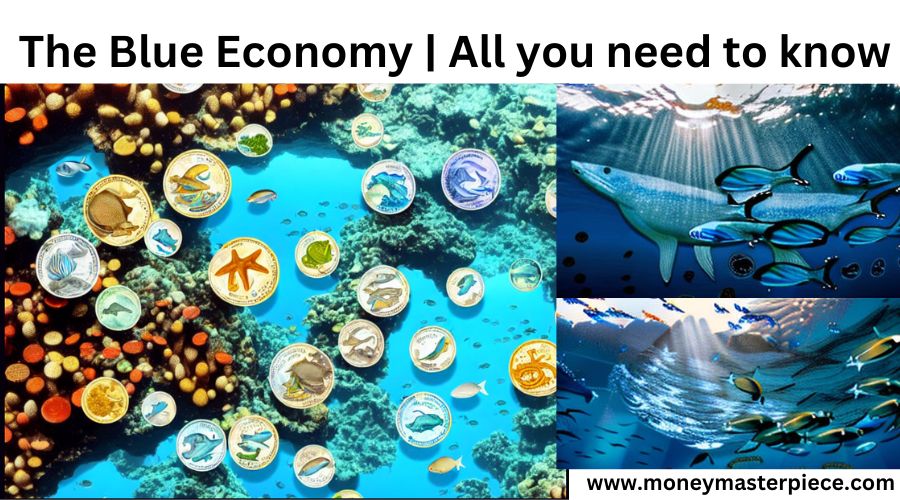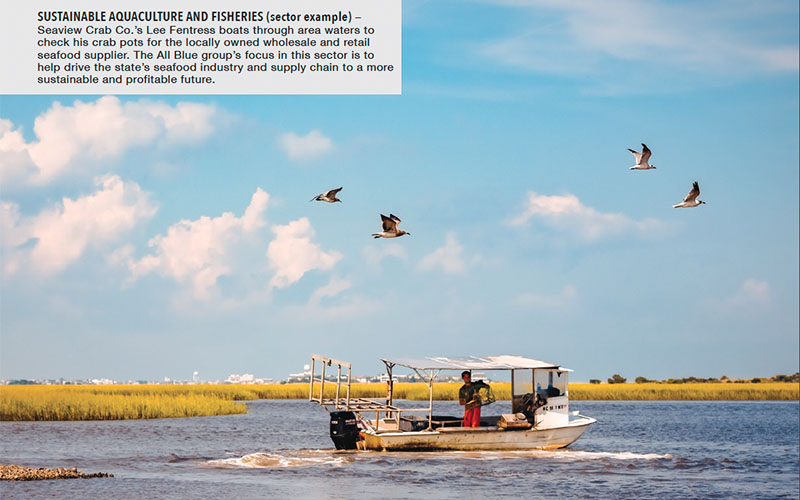The Blue Economy is an approach to economic development that takes into account the sustainable use of marine resources. It encompasses a wide range of activities, including fisheries, aquaculture, tourism, shipping, biotechnology, and renewable energy.
In 2008, the United Nations General Assembly unanimously adopted Resolution A/RES/70/222, declaring June 8 as World Oceans Day. In doing so, they recognized “the role of the oceans in sustaining life on Earth and their immense potential for sustainable development.” The UN also acknowledged “the need for coordinated and concerted action to conserve and sustainably use our ocean resources.”
The Blue Economy is a term that has been used to describe the sustainable use of ocean resources for economic growth, improved livelihoods and jobs, and increased food security. The blue economy concept recognizes that the oceans are a critical source of food, energy, and other vital resources for human beings and must be managed in a way that ensures their long-term health and productivity. While there is no single definition of the blue economy, it typically includes activities such as fisheries management, marine conservation, maritime transport and logistics, tourism, and offshore renewable energy.

The Blue Economy offers a number of benefits, including food security, job creation, poverty alleviation, and climate change mitigation.
Table of Contents
What is Blue Economy?
Most people have heard of the term “blue economy,”. The blue economy is a term that generally refers to the sustainable use of ocean resources for economic growth. This can include everything from fisheries and aquaculture to tourism and shipping.
The blue economy is often seen as an alternative to the traditional extractive industries that have long dominated the oceans, such as oil and gas drilling. These activities can cause environmental damage, so the goal of the blue economy is to find ways to use ocean resources without harming the environment. There are many different ways to do this, and it will likely vary from place to place depending on the local conditions and resources.
However, some common methods include using renewable energy sources like wind or solar power, promoting sustainable fishing practices, and developing environmentally friendly tourist destinations. The blue economy is still in its early stages of development, but it holds a lot of promise for creating jobs and boosting economies while also protecting our oceans.
In recent years, the blue economy has emerged as an important area of focus for policymakers around the world as they seek to find ways to promote economic development while protecting the environment. The blue economy presents a number of opportunities for businesses and investors. For example, companies involved in fisheries management can help to ensure sustainable fish stocks; those involved in maritime transport can develop more efficient shipping routes; and those involved in tourism can promote eco-friendly tourist destinations.
There is also growing interest in investing in offshore renewable energy projects such as wind farms. The blue economy offers immense potential for promoting sustainable development and improving livelihoods around the world. However, its success depends on effective governance at all levels – from local communities to national governments – to ensure that its benefits are shared equitably among all stakeholders.
Blue Economy Countries
There are a number of countries around the world that are leading the way in developing a blue economy. Here are some examples:
Norway: Norway has long been a pioneer in sustainable fisheries management, and it is now working to develop offshore wind farms as a source of renewable energy.
The country is also a leader in ocean-based carbon capture and storage technology, which could play a key role in mitigating climate change. Chile: Chile has one of the longest coastlines in the world, and its seafood industry is worth billions of dollars annually. The country is working to create Marine Protected Areas (MPAs) where fish stocks can rebound, and it is also investing in aquaculture and seaweed farming as alternative sources of income for coastal communities.
Singapore: Singapore’s port is one of the busiest in the world, handling over 20 million containers every year. The city-state has invested heavily in green infrastructures such as electric vehicles and solar panels, and it is working on plans to develop floating farms and vertical gardens.

Credit: blogs.edf.org
What is the Role of the Blue Economy?
The blue economy is a term that has been used to describe the sustainable use of ocean resources for economic growth, improved livelihoods and jobs, and ocean conservation. The blue economy is based on the recognition that the ocean is a key driver of the planet’s natural systems and provides a range of benefits to humanity. These benefits include food, energy, transportation, recreation, tourism and minerals.
The blue economy also encompasses the protection of the marine environment from pollution and degradation. The United Nations General Assembly has recognized the importance of the oceans in achieving Sustainable Development Goal 14 (SDG14), which calls for the conservation and sustainable use of the oceans, seas and marine resources for sustainable development.
As part of this commitment, member states agreed to develop national action plans on ocean-related issues by 2020. One of the key challenges facing implementation of SDG14 is ensuring that economic activities in the maritime sector are compatible with environmental protection. This challenge is addressed through what is known as an Ecosystem Approach to Management (EAM).
EAM takes into account the relationships between different components in an ecosystem – such as fish, coral reefs and seagrasses – and how they interact with each other and their environment. It also considers human activities that can impact upon these ecosystems – such as fishing, coastal development or pollution – and aims to manage these activities in a way that minimizes negative impacts whilst maintaining ecosystem health overall. The adoption of an Ecosystem Approach forms one pillar of SDG14 implementation; another important pillar is Blue Economy thinking.
Blue Economy thinking takes a holistic view of how we can best utilize ocean resources without damaging or depleting them. It focuses on creating new economic opportunities whilst protecting our oceans; on using marine resources sustainably; valuing coastal communities; investing in research & development; adopting innovative technologies; minimizing pollution & waste; encouraging responsible consumption & production patterns…in short, it seeks ways in which we can have our ‘cake’ (i.e., enjoy economic prosperity) without ‘eating’ away at our planet’s finite natural capital reserves (the stock from which we derive renewable resources like fisheries).
What are the Main Components of the Blue Economy?
The Blue Economy refers to a sustainable approach to economic development that focuses on the responsible use and preservation of marine and aquatic resources. Its main components encompass a wide range of activities and sectors related to the oceans, seas, and freshwater bodies. The key components of the Blue Economy include:
- Fisheries and Aquaculture: Sustainable harvesting of fish, shellfish, and aquatic plants is a fundamental component. Aquaculture, or the farming of aquatic organisms, is also a significant part, providing a renewable source of seafood.
- Maritime Transport: This includes shipping, ports, and related logistics. Maritime transport is vital for global trade, and it plays a central role in the efficient movement of goods and commodities.
- Tourism and Recreation: Coastal and marine tourism, including activities such as beach resorts, diving, snorkeling, and cruise tourism, contributes to the Blue Economy. It depends on the preservation of natural coastal environments.
- Renewable Energy: The Blue Economy includes the development of renewable energy sources such as offshore wind, tidal, and wave energy. These technologies harness the power of the ocean to generate electricity.
- Mineral Resources: Extraction of minerals and resources from the seabed, including oil and gas exploration and deep-sea mining, is a part of the Blue Economy. Sustainability and environmental responsibility are crucial in this sector.
- Marine Biotechnology: Research and development related to marine organisms for medical, industrial, and biotechnological applications. This includes the discovery of new pharmaceuticals and bioproducts.
- Marine Conservation: Efforts to protect and conserve marine ecosystems and biodiversity are central to the Blue Economy. Sustainable practices ensure that resources remain available for future generations.
- Maritime Security: Ensuring safety and security in maritime areas, including activities such as search and rescue, law enforcement, and combating piracy and illegal fishing.
- Coastal Infrastructure: Infrastructure development in coastal regions, including the construction and maintenance of ports, harbors, and coastal protection structures, is part of the Blue Economy.
- Research and Education: Advancements in marine science and technology, as well as educational programs related to marine conservation and sustainable practices, are essential for the growth of the Blue Economy.
- Blue Innovation: Encouraging innovation and entrepreneurship in industries related to the oceans, fostering the development of new technologies, products, and services that promote sustainability.
- Maritime and Environmental Law: Establishing and enforcing legal frameworks and regulations that govern activities in marine and coastal areas, including international agreements and conventions.
- Waste Management: Proper management and disposal of marine litter, plastic waste, and pollution prevention are crucial to maintain the health of ocean ecosystems.
The Blue Economy represents a holistic approach to economic development that recognizes the interdependence of economic growth, environmental conservation, and social well-being. It seeks to balance economic opportunities with responsible stewardship of marine and aquatic resources to ensure their sustainability for current and future generations.
The blue economy offers a number of advantages over traditional approaches to development:
1) It is environmentally sustainable: The blue economy focuses on the sustainable use of ocean resources, which are renewable and have less impact on the environment than other forms of energy such as fossil fuels.
2) It is economically viable: The blue economy can create new economic opportunities and jobs while also providing essential goods and services such as food, clean water, and transportation.
3) It benefits local communities: By working with local communities, the blue economy can create shared value that helps to reduce poverty and improve livelihoods.
4) It promotes good governance: Good governance is essential for the successful management of ocean resources. The blue economy provides an opportunity to strengthen institutions and build capacity for effective ocean governance.
Who Benefits from the Blue Economy?
The blue economy is based on the principle of using ocean resources in a way that does not damage the environment or deplete the resources. There are many different sectors that benefit from the blue economy, including fisheries, aquaculture, shipping, tourism, and biotechnology.
The blue economy also provides benefits for those who live in coastal communities and depend on the oceans for their livelihoods. The blue economy is an important part of the global economy and its Sustainable Development Goals. It is estimated that by 2030, the blue economy will be worth $3 trillion and will create up to 40 million jobs.
While the concept of the blue economy is still relatively new, it has the potential to provide significant benefits to both developed and developing countries.
In developed countries, the blue economy can create new jobs and businesses in sectors that are often struggling due to globalization and automation. For example, the declining fishing industry in Europe has been given a new lease on life by the rise of aquaculture. In addition, many developed countries are now looking to offshore wind farms as a source of clean energy.
The blue economy can also help reduce poverty and inequality by providing opportunities for marginalized groups such as women and small-scale fishermen. In developing countries, meanwhile, the blue economy offers a way to escape from poverty trap by harnessing ocean resources that are often underutilized or underexploited. For example, small-scale fisheries can provide an important source of food security and income for coastal communities.
In addition, coastal tourism can be a key driver of economic growth in many developing countries.
The blue economy can provide new opportunities for these people by creating jobs in fisheries, aquaculture, tourism, and other industries. Another advantage of the blue economy is that it can help to reduce poverty. Many coastal communities are among the poorest in the world.
The blue economy can provide new sources of income and help to improve living conditions in these communities.
Conclusion
The blue economy is a term that has been coined to describe the sustainable use of ocean resources for economic growth, improved livelihoods, and jobs while preserving the health of the ocean ecosystem. It is based on three pillars: environmental sustainability, social inclusion, and economic development. A key element of the blue economy is the valuing of natural capital, which takes into account the benefits that ecosystems provide to people, such as food and water provision, carbon sequestration, recreation, and tourism.
In order to achieve sustainable development goals related to the oceans, it is essential to move beyond traditional approaches that have often led to the overexploitation of marine resources. The blue economy provides a framework for doing this by emphasizing conservation and sustainable use in order to maintain healthy oceans and coastal areas that can support prosperous communities.
